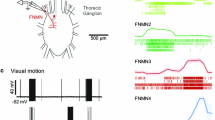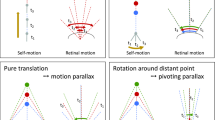Summary
Studies of the optomotor response, the tendency to turn in response to a moving pattern, have yielded some understanding of the motion detection capabilities of the fly. We present data from extracellular microelectrode recordings from the optic lobes of the housefly, Musca domestica and the blowflies Eucalliphora lilaea and Calliphora phaenicia. Directionally selective and directionally nonselective motion sensitive units were observed in the region between the medulla and the lobula of all three species. Employing similar stimulus conditions to those used in the optomotor reaction studies, it was found that the response of the directionally selective units exhibited most of the characteristics of the optomotor response torque measurements. It is concluded that these units code the information prerequisite to the optomotor response and hence, that much data processing is achieved in the first few synaptic layers of the insect visual nervous system.
Similar content being viewed by others
References
Barlow, H. B., and W. R. Levick: The mechanism of directionally selective units in rabbit's retina. J. Physiol. (Lond.) 178, 477–504 (1965).
Bishop, L. G., and D. G. Keehn: Two types of motion sensitive neurons in the optic lobe of the fly. Nature (Lond.) 212, 1374–1376 (1966).
Braitenberrg, V.: Personal communication (1966).
Burkhardt, D.: Optical properties of the insect eye. Proc. Symp. on Information Processing in Sight Sensory Systems, Calif. Inst. Tech., p. 75–84 (1965).
Burtt, E. T., and W. T. Catton: Electrical responses to visual stimulation in the optic lobes of the locust and certain other insects. J. Physiol. (Lond.) 133, 68–88 (1956).
Fermi, G. V., u. W. Reichardt: Optomotorische Reaktionen der Fliege Musca domestica. Kybernetik 2, 15–28 (1963).
Goetz, K. G.: Behavioral Analysis of the visual system of the fraitfly Drosophila. Proc. Information Processing in Sight Sensory Systems, California Institute of Technology, p. 85–100 (1965).
Green, J. D.: A simple microelectrode for recording from the central nervous system. Nature (Lond.) 182, 962 (1958).
Hartline, H. K., and F. Ratliff: Inhibitory interaction of receptor units in the eye of Limulus. J. gen. Physiol. 40, 357–376 (1956).
Horridge, G. A.: Extracellular recordings from single neurons in the optic lobe and brain of the locust. In: The physiology of the insect central nervous system. London and New York: Academie Press 1965.
McCann, G. D., and G. F. MacGinitie: Optomotor response studies of insect vision. Proc. roy. Soc. B 163, 369–401 (1965a).
McCann, G. D.: Correlated studies of insect visual nervous systems. Proc. Symp. on Functional Organization of Compound Eyes, Stockholm, Sweden (1965b), in press.
Vowles, D. M.: Proc. roy. Loc. B, in press (1965).
Author information
Authors and Affiliations
Rights and permissions
About this article
Cite this article
Bishop, L.G., Keehn, D.G. Neural correlates of the optomotor response in the fly. Kybernetik 3, 288–295 (1967). https://doi.org/10.1007/BF00271512
Received:
Issue Date:
DOI: https://doi.org/10.1007/BF00271512




